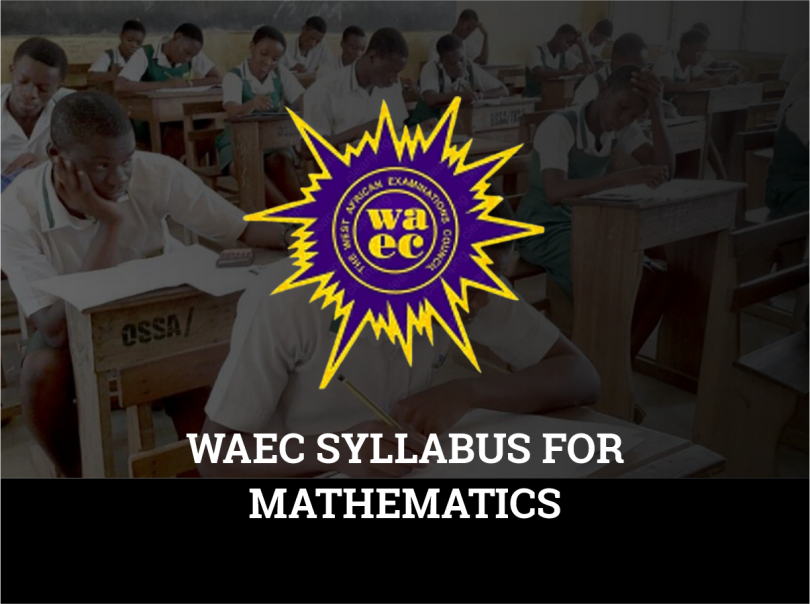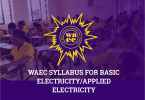WAEC Syllabus For Mathematics 2025 – Mathematics is one of the most important subjects you need to pass in the WAEC exam. If you fail Mathematics, you may not be able to use your WAEC certificate to gain admission, unless you combine it with another certificate or you resit WAEC. Because of this, it’s very important to revise well and use all the resources you can find.
The best place to start is the WAEC Mathematics syllabus. The WAEC Syllabus for Mathematics will help you focus on the topics you need to study and give you an idea of the kinds of questions to expect. If you are writing WAEC this year or you are a Math tutor helping others, make sure you check out the full syllabus below so you can begin your revision in the right direction.
Examination Structure
The examination consists of two papers, both of which are mandatory.
Paper 1: This paper will have 50 multiple-choice questions, covering topics from the common sections of the syllabus. It will last for 1½ hours and is worth 50 marks.
Paper 2: This paper includes thirteen essay-style questions divided into two sections.
- Section A: This section contains five compulsory questions, which are relatively straightforward. It is worth 40 marks and will focus on the common areas of the syllabus.
- Section B: This section consists of eight more challenging questions. It includes up to two questions that may not be directly related to candidates’ home countries. Candidates are required to answer five questions for a total of 60 marks.
WAEC Syllabus For Mathematics 2025
| TOPIC | CONTENT | NOTES |
|---|---|---|
| A. NUMBER AND NUMERATION | ||
| (a) Number bases | (i) Conversion of numbers from one base to another | Conversion from one base to base 10 and vice versa. Conversion from one base to another base. Addition, subtraction, and multiplication of number bases. |
| (ii) Basic operations on number bases | ||
| (b) Modular Arithmetic | (i) Concept of Modulo Arithmetic | Interpretation of modulo arithmetic e.g. 6 + 4 = k(mod7), 3 x 5 = b(mod6), m = 2(mod3). Relate to market days, clock, shift duty, etc. |
| (ii) Addition, subtraction and multiplication operations in modulo arithmetic | ||
| (iii) Application to daily life | ||
| (c) Fractions, Decimals and Approximations | (i) Basic operations on fractions and decimals | Approximations should be realistic e.g. a road is not measured correct to the nearest cm. |
| (ii) Approximations and significant figures | ||
| (d) Indices | (i) Laws of indices | Include simple examples of WAEC Syllabus |
| (ii) Numbers in standard form (scientific notation) and negative and fractional indices | Expression of large and small numbers in standard form e.g. 375300000 = 3.753 x 10^8, 0.00000035 = 3.5 x 10^-7 | |
| (e) Logarithms | (i) Relationship between indices and logarithms | |
| (ii) Basic rules of logarithms | Calculations involving multiplication, division, powers, and roots. | |
| (iii) Use of tables of logarithms and antilogarithms | ||
| (f) Sequence and Series | (i) Patterns of sequences | Simple cases only, including word problems. (Include sum for A.P. and exclude sum for G.P). |
| (ii) Arithmetic progression (A.P.) and Geometric Progression (G.P.) | ||
| (g) Sets | (i) Idea of sets, universal sets, finite and infinite sets, subsets, empty sets, and disjoint sets | Use of Venn diagrams restricted to at most 3 sets. |
| (ii) Solution of practical problems involving classification using Venn diagrams | ||
| (h) Logical Reasoning | Simple statements, true and false statements, negation of statements, implications | |
| (i) Positive and negative integers | The four basic operations on rational numbers | |
| (j) Surds (Radicals) | Simplification and rationalization of simple surds | Basic operations on surds (exclude surds of the form √a, b√a, etc.) |
| (k) Matrices and Determinants | (i) Identification of order, notation and types of matrices | Application to solving simultaneous linear equations in two variables. Restrict to 2×2 matrices. |
| (ii) Addition, subtraction, scalar multiplication, and multiplication of matrices | ||
| (iii) Determinant of a matrix | ||
| (l) Ratio, Proportions, and Rates | Ratio between two similar quantities | Relate to real-life situations like financial partnerships, taxes, etc. |
| (m) Percentages | Simple interest, commission, discount, depreciation, profit and loss, compound interest, hire purchase, and percentage error | Limit compound interest to a maximum of 3 years |
| (n) Financial Arithmetic | (i) Depreciation/Amortization | |
| (ii) Annuities | ||
| (iii) Capital Market Instruments | Shares/stocks, debentures, bonds, simple problems on interest on bonds and debentures. | |
| (o) Variation | Direct, inverse, partial and joint variations | Application to simple practical problems |
| B. ALGEBRAIC PROCESSES | ||
| (a) Algebraic expressions | (i) Formulating algebraic expressions from given situations | Example: C = 4x + 3y |
| (ii) Evaluation of algebraic expressions | ||
| (b) Simple operations on algebraic expressions | (i) Expansion | Binary Operations like (a+b)(c+d), ax²+bx+c |
| (ii) Factorization | Application of difference of two squares | |
| (iii) Binary Operations | ||
| (c) Solution of Linear Equations | (i) Linear equations in one variable | |
| (ii) Simultaneous linear equations in two variables | Word problems involving one or two variables | |
| (d) Change of Subject of a Formula | (i) Change of subject of a formula/relation | |
| (ii) Substitution | Example: v = u + f | |
| (e) Quadratic Equations | (i) Solution of quadratic equations | Simple rational roots only |
| (ii) Forming quadratic equation with given roots | ||
| (iii) Application of solution of quadratic equations in practical problems | ||
| (f) Graphs of Linear and Quadratic functions | (i) Interpretation of graphs, coordinates of points, table of values | Determining maximum/minimum points on the graph, intercepts on the axes, identifying axis of symmetry. |
| (ii) Graphical solution of a pair of equations | ||
| (iii) Drawing tangents to curves to determine gradient at a given point | ||
| (g) Linear Inequalities | (i) Solution of linear inequalities in one variable | Truth set representation on the number line |
| (ii) Graphical solution of linear inequalities in two variables | ||
| (h) Algebraic Fractions | Operations on algebraic fractions with: (i) Monomial denominators (ii) Binomial denominators | Simple cases only |
| (i) Functions and Relations | Types of functions | |
| C. MENSURATION | ||
| (a) Lengths and Perimeters | (i) Use of Pythagoras theorem, sine and cosine rules to determine lengths and distances | No formal proofs required. |
| (ii) Lengths of arcs of circles, perimeters of sectors and segments | ||
| (iii) Longitudes and Latitudes | ||
| (b) Areas | (i) Triangles and special quadrilaterals – rectangles, parallelograms, and trapeziums | Include area of triangle = ½ base x height |
Units and Symbols
Candidates should familiarize themselves with the following units and their respective symbols:
Length
- 1000 millimetres (mm) = 100 centimetres (cm) = 1 metre (m)
- 1000 metres (m) = 1 kilometre (km)
Area
- 10,000 square metres (m²) = 1 hectare (ha)
Capacity
- 1000 cubic centimetres (cm³) = 1 litre (l)
Mass
- 1000 milligrams (mg) = 1 gram (g)
- 1000 grams (g) = 1 kilogram (kg)
- 1000 kilograms (kg) = 1 tonne
Currencies
- The Gambia: 100 bututs (b) = 1 Dalasi (D)
- Ghana: 100 Ghana pesewas (Gp) = 1 Ghana Cedi (GH₵)
- Liberia: 100 cents (c) = 1 Liberian Dollar (LD)
- Nigeria: 100 kobo (k) = 1 Naira (N)
- Sierra Leone: 100 cents (c) = 1 Leone (Le)
- UK: 100 pence (p) = 1 pound (£)
- USA: 100 cents (c) = 1 dollar ($)
- French-speaking territories: 100 centimes (c) = 1 Franc (fr)
Other Important Information
- Candidates are permitted to use WAEC-approved Mathematics and Statistical tables in the exam.
- If no specific degree of accuracy is mentioned in a question, candidates should use the degree of accuracy that can be obtained from these tables.
- Only non-programmable, silent, and cordless calculators are allowed.
- The calculators should not have the capability to print or send/receive information.
- Phones, whether with or without calculators, are strictly prohibited in the examination room.
- Candidates are required to bring essential materials such as rulers, compasses, protractors, and set squares for the exam.
- Borrowing any materials from other candidates is not permitted in the examination hall.
- For papers where required, graph papers with 2mm squares will be provided.
- Although the use of mathematical tables and calculators is allowed as outlined above, it is important to note that some questions may prohibit the use of these tools.
We wish you the best of luck in your examinations.
We hope this post was helpful. If you have questions, please reach out to us in the comments nd we will respond shortly. Do not forget to share.







Leave a Comment